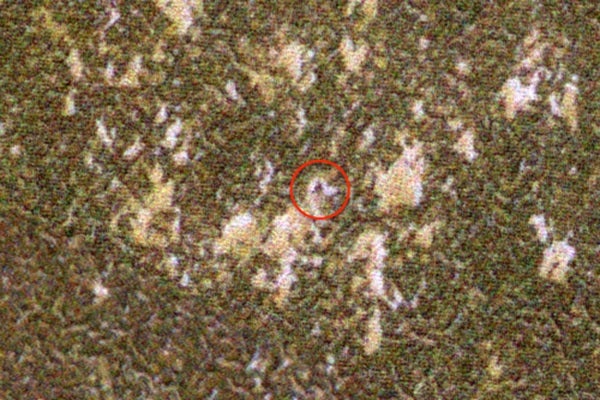Winter images of NASA’s Phoenix Lander show the lander shrouded in dry-ice frost on Mars. The High Resolution Imaging Science Experiment (HiRISE) camera aboard NASA’s Mars Reconnaissance Orbiter captured the images.
The HiRISE camera team at the University of Arizona, Tucson, captured one image of the Phoenix Lander July 30, 2009, and the other August 22, 2009. That’s when the Sun began peeking over the horizon of the northern polar plains during winter, the imaging team said. The first day of spring in the northern hemisphere began October 26.
“We decided to try imaging the site despite the low light levels,” said HiRISE team member Ingrid Spitale of the University of Arizona Lunar and Planetary Laboratory.
“The power of the HiRISE camera helped us see it even under these poor light conditions,” said HiRISE team member Michael Mellon of the University of Colorado in Boulder, who was also on the Phoenix Mars Lander science team.
The HiRISE team targeted their camera at the known location of the lander to get the new images and compared them to a HiRISE image of the frost-free lander taken June 2008. That enabled them to identify the hardware disguised by frost, despite the fact that their views were hindered by poor lighting and by atmospheric haze, which often obscures the surface at this location and season.
Carbon dioxide frost blankets the surface in both images. The amount of carbon dioxide frost builds as late winter transitions to early spring, so the layer of frost is thicker in the August 22 image.
HiRISE scientists noted that brightness doesn’t necessarily indicate the amount of frost seen in the images because of the way the images are processed to produce optimal contrast. Even the darker areas in the frost-covered images are still brighter than typical soil that surrounds the lander in frost-free images taken during the lander’s prime mission in 2008.
Other factors that affect the relative brightness include the size of the individual grains of carbon dioxide ice, the amount of dust mixed with the ice, the amount of sunlight hitting the surface, and different lighting angles and slopes, Spitale and Mellon said.
Studying these changes will help us understand the nature of the seasonal frost and winter weather patterns in this area of Mars.
Scientists predicted that the ice layer would reach maximum thickness in September 2009, but they don’t have images to confirm that because HiRISE camera operations were suspended when Mars Reconnaissance Orbiter entered an extended safe mode August 26.
The Phoenix Mars Lander ceased communications last November, after successfully completing its mission and returning unprecedented primary science phase and returning science data to Earth. During the first quarter of 2010, teams at JPL will listen to see if Phoenix is still able to communicate with Earth. Communication is not expected and is considered highly unlikely following the extended period of frost on the lander.
Use Astronomy.com’s interactive star chart, StarDome, to locate and observe Mars in your sky. Click on the StarDome graphic to the right. Be sure to find and set your location under “Location Settings.” After you’ve set your location, click on “Show Names” — located just to the lower right of the star chart — and select “Mark One Specific Object.” Scroll down to find “Mars” from the list of objects. Highlight it and click OK.
If Mars is visible from your location, it will appear on the map. Track the object’s motion across the sky by adjusting the figures under “Date and Time Settings.”











